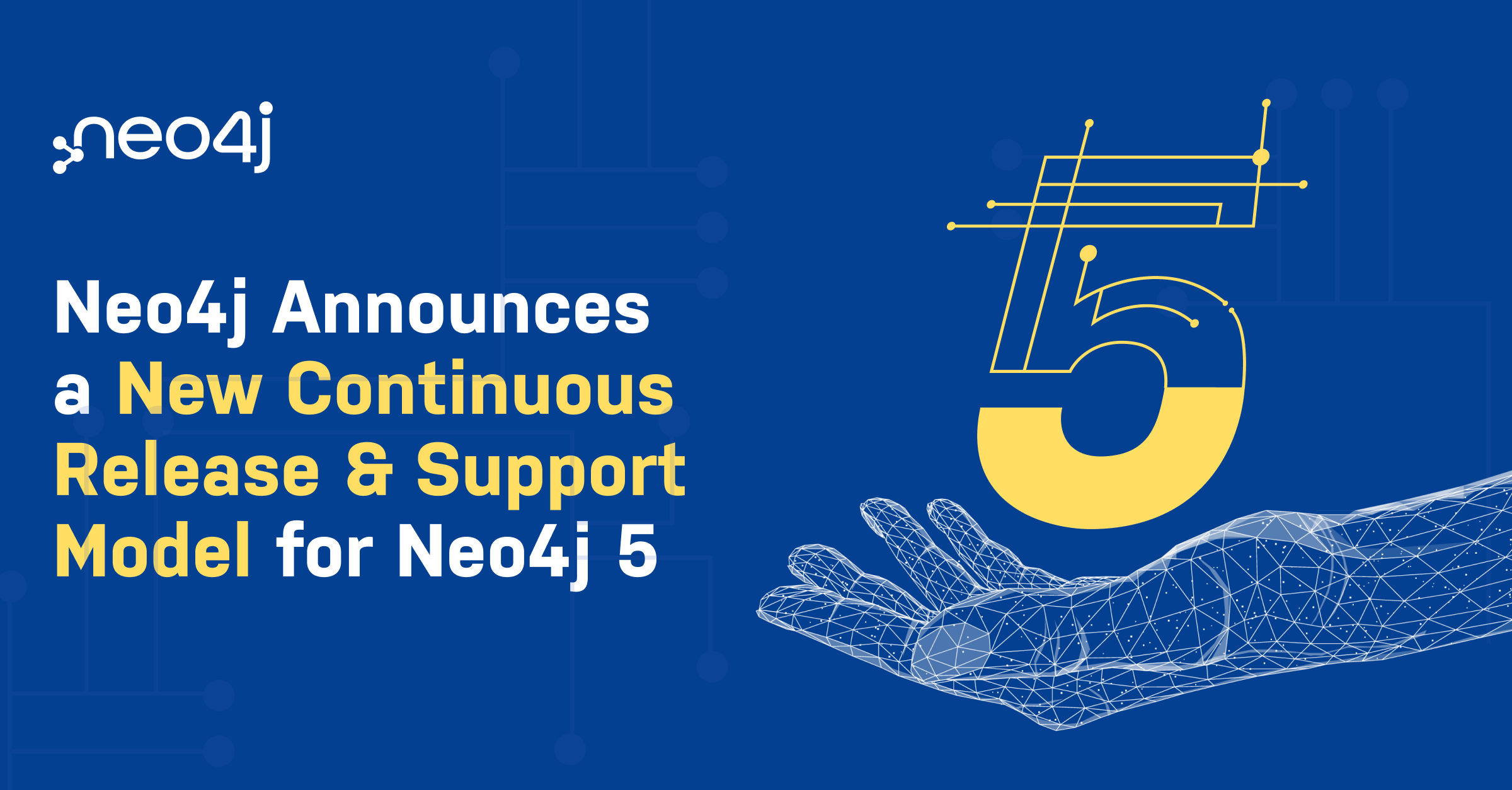We are excited to announce the introduction of Neo4j 5 and our new continuous release and product support model for our database platform designed for the cloud (for full details, please read the support terms). In keeping with DevOps deployment practices, this version enables customers to integrate Neo4j into their application deployment pipeline for their SaaS or Enterprise Graph Platform and deliver the same great features and fixes that our Aura customers benefit from.

This new continuous release model is a departure from our traditional branched product support model, where each release was supported with hotfixes for 18 months, and the final Long Term Support (LTS) version was supported for 36 months. Now, customers will receive frequent minor releases with new features and fixes that are supported with hotfixes until the next minor release. Additionally, now the LTS version will be supported for a total of 42 months.
For customers who prefer to deploy versions of products that do not introduce new features, we continue to offer Neo4j 4.4 LTS under our previous terms. The shift to the new continuous release model is accompanied by an extended migration window.
Customers now have one year to move between LTS versions of Neo4j 4.4 and Neo4j 5.LTS (previously this was only six months). Customers receive the same level of product support whether they remain on the current LTS version or decide to adopt Neo4j 5 now with a continuous feature release mode – or wait for Neo4j 5 to become an LTS version. Dates for each release are published here.
Along with this new release model, Neo4j 5 includes a few very helpful new features to ease migrations and upgrades:
- Any-to-any upgrade within Neo4j 5 (new): You can now skip any minor version of 5, and upgrade directly to a later version of 5. This includes the rolling upgrade (zero downtime) of autonomous clusters.
- Reliable and safe database / server eviction (new): This feature is perfect for orchestration platforms like Kubernetes. You can now script the reallocation and deallocation of databases from servers (or servers from clusters) with confidence that there won’t be any interruption to fault tolerance.
- Helm Charts for Neo4j 5 (new): Enable you to deploy Neo4j on Kubernetes and use Autonomous Clustering and automatically deploya load balancer.
- Near zero downtime migration (new) from Neo4j 4.4 to Neo4j 5: Compared to previous migrations, migration time does not depend upon the size of the database because only metadata is updated to migrate the Neo4j 4.4 database to Neo4j 5. All other preparatory steps can be performed while the database is online.
And we have a few improvements to share with you as well:
Frequently Asked Questions
Where is Neo4j 5.0? I can only see the latest version available. Neo4j 5.0 was a Limited Availability release that was made available to select customers. Neo4j 5.1 was the Generally Available release for our platform that includes compatibility for all our products. As we publish the new minor version, we retire the previous minor version from the download page.
I have a previous minor version installed and I need to download another copy? Please login to the Neo4j Support Portal to locate a knowledge base article titled Downloads for Commercial Customers, which contains a link.
Do I have to start at Neo4j 5.1, and then upgrade to each minor version in turn? Nope. You can deploy any minor version e.g. 5.5 and then upgrade straight to 5.8 if you want.
Can I remain on any minor version e.g. Neo4j 5.1 if I want to, or do I have to apply the new minors when they come out? Yes, you can remain on Neo4j 5.1, or any other version if you want to, and you may still contact support if you have a valid support contract. If you report an issue that was resolved in a more recent minor version, you will be asked to upgrade to the latest version to resolve the problem.
How does any-to-any version upgrade work? Any-to-any upgrade is our best effort* to provide an upgrade path from any Neo4j 5 version to any later Neo4j 5 version. This is unlike Neo4j 4.x, where you had to upgrade in sequence from 4.1 to 4.2 to 4.3.
*In the event a bug is identified that prohibits a particular path, we will advertise this. For example, an exception may be required to pass through Neo4j 5.4 before you can go to any version after that.
Does the upgrade process cover hotfix releases? Yes, you can apply the upgrade process to minor or hotfix releases, and go from any version to any other.
What is rolling-upgrade, and how does it ensure zero downtime? A rolling upgrade describes our process of upgrading the database management servers in a cluster, one member at a time – thereby ensuring that the databases are always available.
How does Deallocate work to enable server maintenance? Deallocate informs Autonomous Clustering to start copying the database(s) to another server in the Cluster so you can perform a maintenance operation. Only after the operation is complete and the database is ready on the new server will the copy be removed from the current server. Servers that are marked for deallocation cannot be used to start hosting new databases.
I want to migrate to Neo4j 5 – do I have to migrate to Neo4j 5.1 to start? No, you can migrate from Neo4j 4.4 (recommend latest hotfix) to any minor version, e.g. Neo4j 5.6.
What about Critical Security Vulnerabilities? Our commitment to releasing CVEs remains unchanged – they will be addressed based upon their rating in the National Vulnerability Database. If a critical fix is required between minor releases, we will issue a hotfix for the current minor version only.



